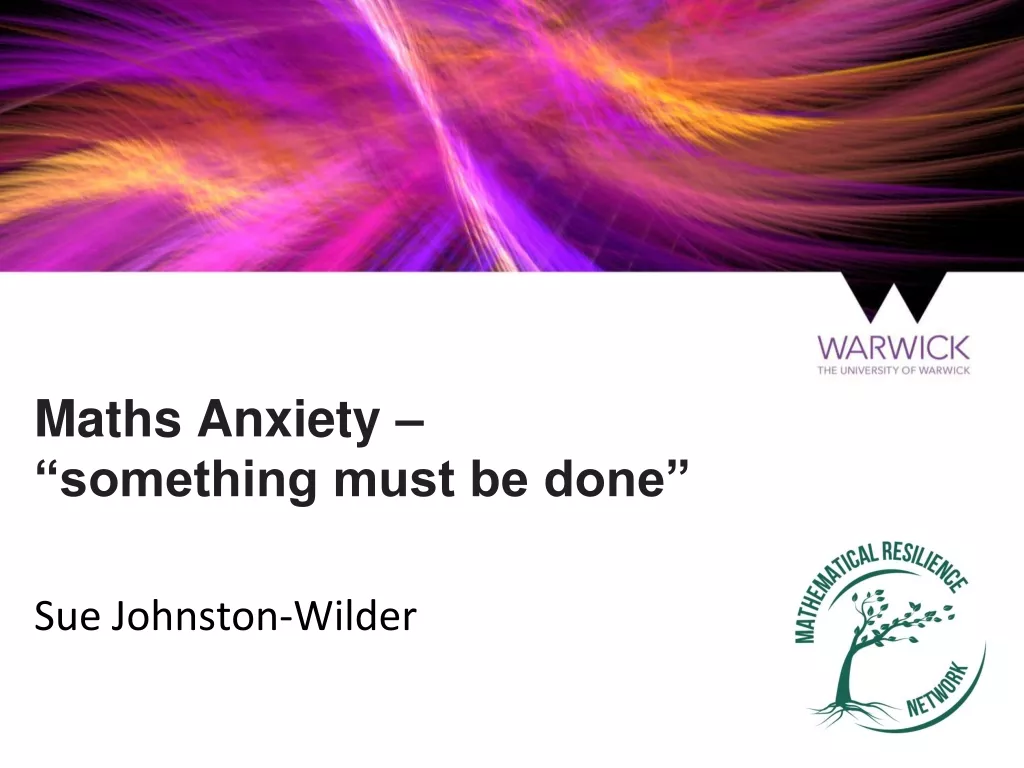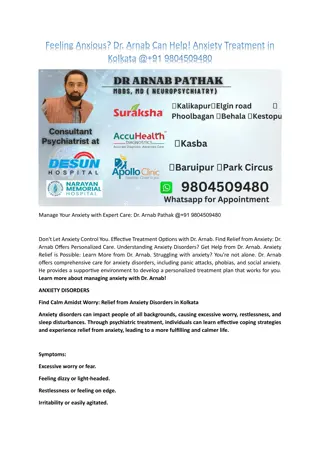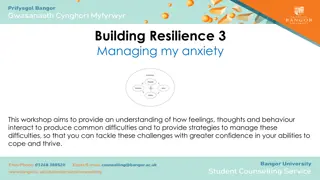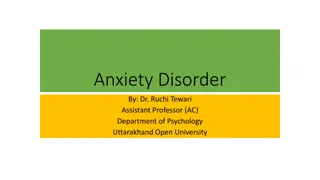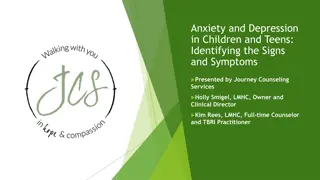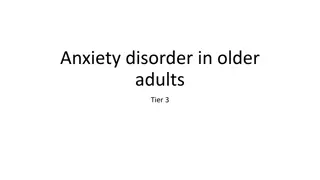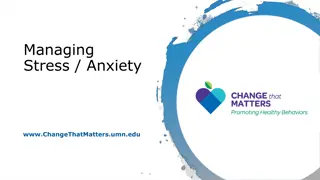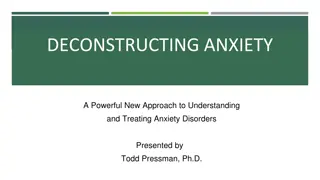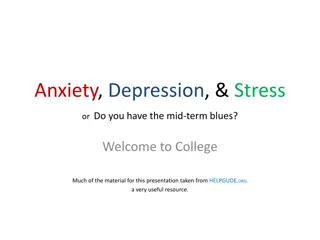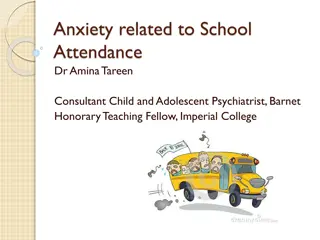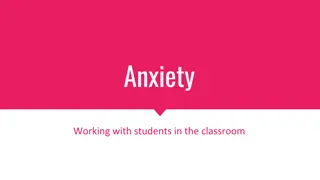Understanding Anxiety and Techniques to Manage It
Anxiety is a common experience that can impact individuals of all ages. It is important to recognize the effects of anxiety and worry on everyday life and explore techniques to reduce and control these feelings. This session delves into the nature of anxiety, its prevalence among young people, and the ways in which anxiety can be managed effectively. By understanding anxiety better and learning practical strategies, individuals can improve their well-being and cope with stressors more effectively.
Download Presentation

Please find below an Image/Link to download the presentation.
The content on the website is provided AS IS for your information and personal use only. It may not be sold, licensed, or shared on other websites without obtaining consent from the author. Download presentation by click this link. If you encounter any issues during the download, it is possible that the publisher has removed the file from their server.
E N D
Presentation Transcript
Aims of session Look at what anxiety/worry is How worry affects you. Discuss techniques that can be used to help reduce/control anxiety/worries.
Exam stress Exam stress is a feeling of pressure that many young people feel coming up to exam time. It usually occurs during the revision period before exams and immediately before the exams. Stress is defined as an individual's response to pressure.
How common is anxiety? Fears and worries are a normal part of growing up and are experienced by all children. Anxiety has been found to be one of the most common causes of distress in children and young people. Statistics in an average school class 5 pupils will have experienced (clinical) anxiety.
What is anxiety/worry? Experiences of anxiety vary greatly from person Anxiety/worry is a completely normal emotion we all experience it from time to time (think back to an exam, your first day at Greenbank High School) Being anxious can even be healthy at times, can you think of any examples of this?
What is anxiety/worry? Anxiety only interferes with our performance in our everyday lives i.e. it stops you activities/things that enjoy. becomes a problem when it from doing certain We cannot banish anxiety completely from our lives but we can learn to manage it.
What is anxiety? (cont.) The Caveman Story! (1) Being Afraid We are all scared of things sometimes. Being frightened of something can even be healthy at times For example, being scared of getting too close to a fire could save you from getting burnt. Being a bit scared can also help you to perform better, for example, in a school race on sports day.
The Caveman Story! (2) What Happens When You re Scared? When you feel scared there are things that happen to your body to prepare it to deal with danger. The body s reaction to fear (being scared) is called the fight or flight response. Here s how the fight or flight response works Imagine you re a caveman all those 100,000s of years ago and one day whilst you are out hunting you come face to face with a hungry tiger. You have three choices
The Caveman Story! (3) 1) You could run as fast as you can This is flight
The Caveman Story! (4) 2) You could pick up your club and you could fight with the tiger This is fight
The Caveman Story! (5) 3) You could do nothing This is called freezing mental block Sometimes people freeze when they become scared, they feel like they can t do anything. This is when you can t remember things
What The Caveman Story Tells Us We have learnt what our bodies do when we are scared and how our body gets ready for fight or flight Our bodies get ready for fight or flight when there is something dangerous, but sometimes our bodies may get ready for fight or flight when there is no danger. Both of these make us feel scared, so it can be difficult to tell if there is something dangerous or not. These feelings can be very frightening and sometimes anxiety can get in the way of things you need to do and want to do, like sleeping, doing school work, visiting new places or playing with your friends.
What else the Caveman story tells us So, remember Anxiety is a normal healthy feeling. It happens to everyone at times of danger or in a situation where you feel worried.
What does anxiety look like for us? Imagine an anxiety provoking situation i.e. an exam, going to a new place, performing.. How do you feel physically? What emotions are around, what do you notice about the way that you are feeling? What thoughts are going through your mind? How are you behaving (what are you doing or what do you want to do)?
What does anxiety look like for us? 2189211 1-1934916-7631-t
The Anxiety Roundabout TRIGGER Exam, show, sport, new place THOUGHTS BEHAVIOUR (What you do) Forget, cry, moody, happy , hyper, quiet, emotional FEELINGS IN YOUR BODY Nerves, sweat, sickness, heart rate,
The Anxiety Roundabout(2) The roundabout is a way of making sense of anxiety and the different parts of anxiety that we have noticed:- Thoughts Feelings in your body (physiology) Behaviour (what you do) It reminds us that different situations, or triggers, put different people onto the roundabout It also helps us understand how easy it is to get stuck on the roundabout because the different parts of anxiety are all working together to keep anxiety going and increasing (just like being stuck on a real roundabout!)
The Anxiety Roundabout(3) But each of the different parts of anxiety Thoughts Feelings in your body Behaviour can also offer us ways off the roundabout, or exits, and we can learn strategies that help us to take these exits Now we are going to talk about some anxiety management strategies and how they map onto the roundabout as exits
Strategies for overcoming anxiety: Breathing exercises and relaxation to solve physical symptoms When we get worried/anxious our breathing speeds up and becomes shallower. Becoming aware of our breathing and learning to slow down and deepen each breath allows us to feel more relaxed. Rating scale: how do we feel (0-10) Practice by: Finger breathing Mindfulness breathing. Squeezing lemons!! Rating scale: how do we feel (0-10)
The Anxiety Roundabout TRIGGER THOUGHTS BEHAVIOUR (What you do) FEELINGS IN YOUR BODY solution
Thoughts . Strategies for overcoming anxiety: Overcoming negative thoughts with coping self talk As we have already discovered some of our thoughts are not helpful. In fact they make us feel more anxious or worried. These thoughts make us think that things will go wrong and make us expect that bad things will happen. Learning to identify and replace these thoughts with coping self talk will help a you to feel better.
Thoughts. What if ? Thinking the worst possible thing will happen.- catastrophy Compare and despair. These may translate into: Everybody's looking at me , I will never pass my exams . Nobody likes me What if I forget my lines.
Combating -ve thoughts. It s important to remember that these are just thoughts, NOT facts, and rarely happen unless you don t prepare Learn to recognise them, and then balance them out with some positive thinking. Learn to not over exaggerate these thoughts We can do this with positive, realistic coping statements.
Positive self talk , imagery TRIGGER THOUGHTS BEHAVIOUR (What you do) FEELINGS IN YOUR BODY
The Anxiety Roundabout These are just some of the exits off the roundabout, we re sure you know of and can find more TRIGGER THOUGHTS BEHAVIOUR (What you do) FEELINGS IN YOUR BODY
Thoughts . Behaviours: Overcoming changes in behaviour As we have already discovered some of our behaviours are not helpful. In fact they make us feel more anxious or worried. These behaviours make us think that things will go wrong and make us expect that bad things will happen. Learning to identify and replace these behaviours with others will help a you to feel better.
Just before the exam.. Typical exam students Those who genuinely know their stuff Those who say they know all their stuff Those that say they know nothing
Different behaviours Emotions Teary Changes Loud Sit on own or with one other person That s ok Chatty Quiet Moody Happy/exciteable
The Anxiety Roundabout TRIGGER THOUGHTS BEHAVIOUR (What you do) FEELINGS IN YOUR BODY
Strategies for overcoming anxiety: Final points to keep in mind .. Anxiety/worry can get worse before it gets better Why?...Because confronting fears places a focus on anxiety. You can think of worry like a bully, when you start to challenge worry/anxiety, it can work harder, but it will get easier as anxiety gets weaker. Anxiety is normal but it s important to build the skills to cope with it.
Skills that we have learnt today. Mindfulness breathing. Video clip Finger breathing. Video clip Squeezing lemons. Positive coping cards. Guided visualisation. EMOTIONAL TOOLKITS.


